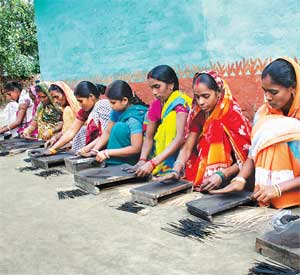Economic Empowerment of Women
 These projects aim to genderise development by creating sustainable income opportunities for women by mobilising them into self-help groups, promoting thrift and linking them to financial institutions for access to credit. A total of 1,035 SHGs were functional during the year, with a membership of more than 14,000 women handling a total micro-credit corpus of Rs 1.79 crores. In addition, the groups raised Rs 98 lakhs as loans from banks for various income generation activities during the year. 7,010 women were gainfully employed, either through micro-enterprises (1,641) or as self-employed (5,369), through income generation loans. These projects aim to genderise development by creating sustainable income opportunities for women by mobilising them into self-help groups, promoting thrift and linking them to financial institutions for access to credit. A total of 1,035 SHGs were functional during the year, with a membership of more than 14,000 women handling a total micro-credit corpus of Rs 1.79 crores. In addition, the groups raised Rs 98 lakhs as loans from banks for various income generation activities during the year. 7,010 women were gainfully employed, either through micro-enterprises (1,641) or as self-employed (5,369), through income generation loans.
 2.2 2.2 crores total turnover of women managed micro-enterprises, the bulk of which was accounted for by the sale of raw and scented agarbattis and chikankari garments & petty business |
|
The total turnover of women-managed micro-enterprises during the year was Rs 2.2 crores, the bulk of which was accounted for by the sale of raw and scented agarbattis and petty business. These activities created 68,628 persondays of employment and a wage bill of Rs 25 lakhs for poor women.
|

